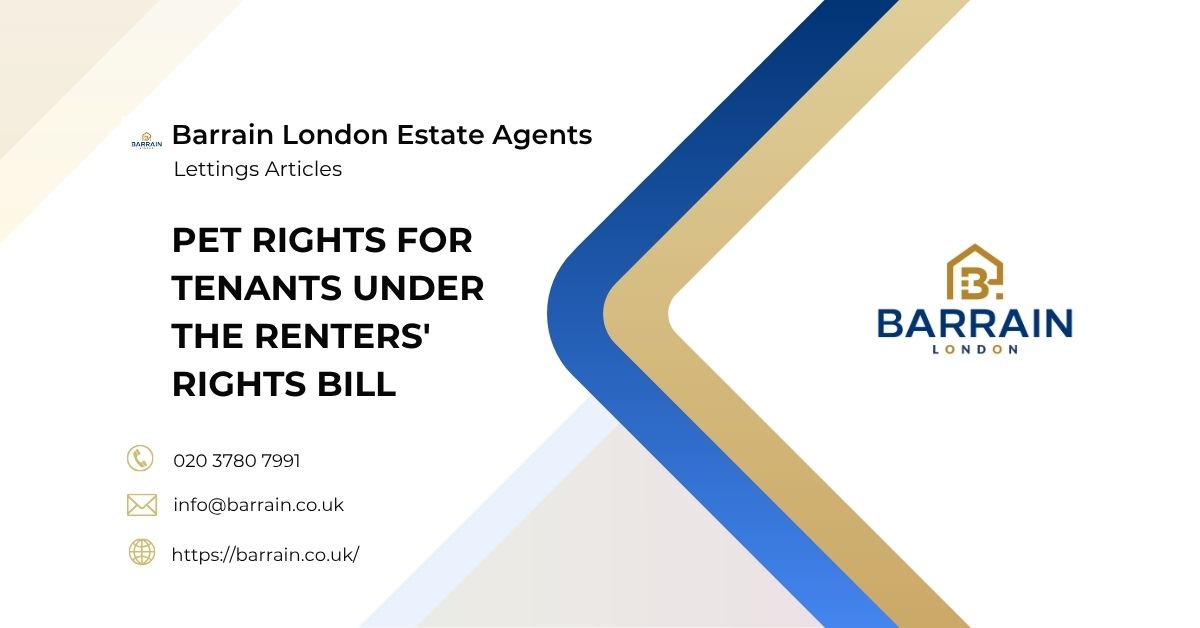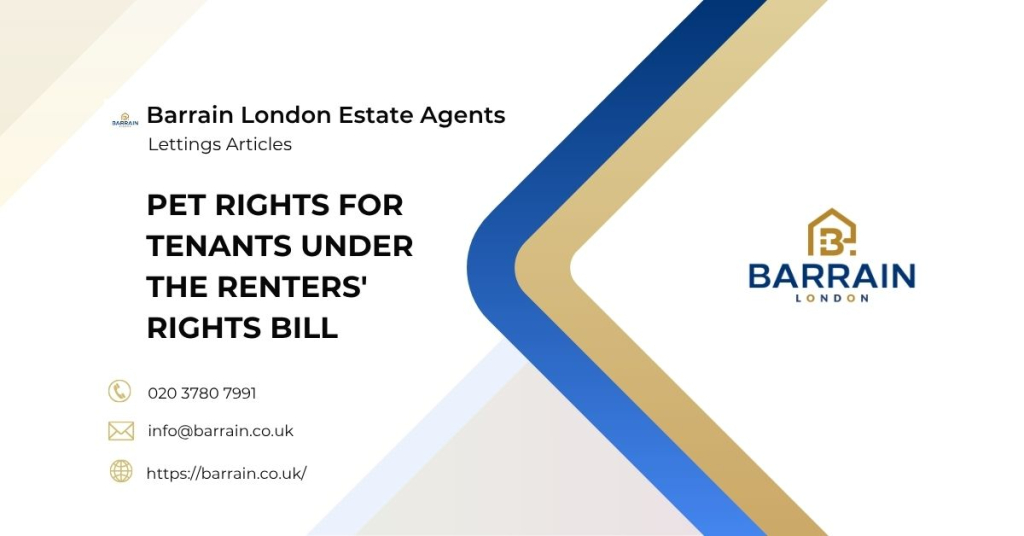What does the Renters’ Rights Bill actually say about pets in rental homes?
The Renters’ Rights Bill gives tenants a fairer opportunity to keep pets in rented accommodation. If a tenant wants to keep a pet, they can now submit a written request. Landlords must respond within 28 days and provide a clear reason if they refuse. Landlords may request that tenants hold pet insurance, but they cannot refuse permission purely on personal views. These new tenancy pet rights strengthen legal protection for responsible renters.
What We Have Covered In This Article?
- Why pet rights in rentals are changing
- What the Renters’ Rights Bill actually says about pets
- What tenants are allowed to do (legally and practically)
- What landlords can and cannot refuse
- How to know if a refusal is reasonable or not
- What happens in complex situations or grey areas
- Pet friendly property search tips
- Landlord checklist for evaluating pet requests
- Q and A: Common tenant misconceptions
- The role of letting agents
- Why pets in homes matter: emotional and social benefits
- Template tools to make your case or respond clearly
- Flowchart: How the pet request process works
- What to do if things go wrong: refusals, appeals and disputes
- Your rights, responsibilities and the road ahead
Why pet rights in rentals are changing
Pets are considered family members by many tenants, yet strict no pet clauses have long made renting with animals difficult. These clauses have led to forced rehoming, distress, and even abandonment. With more people renting for longer periods, the welfare of pets has become part of housing reform.
The new legislation balances household wellbeing with landlord protection. It addresses the growing need for pet friendly housing while maintaining property standards. This guide supports tenants, landlords and letting agents by laying out what each party can and cannot do.
What the Renters’ Rights Bill actually says about pets
This legislation introduces a clear process:
Tenants must submit a written request to keep a pet
Landlords have 28 days to reply in writing
Refusals must include a clear and reasonable explanation
An extra seven days may be used to seek clarification
Landlords can request pet insurance to cover property damage
Exceptions include leasehold bans, building management rules and restrictions on houses in multiple occupation. These must be communicated clearly and in writing. More details can be found on GOV.UK and Shelter UK for those seeking trusted guidance on tenant pet permission.
Pro Tip:A strong pet profile with vet records and behaviour notes improves your chances.
Ehab Barrain
Managing Director at Barrain Estate Agents London
Find a Pet Friendly Home Fast
We specialise in matching tenants with pet friendly properties across London and beyond. Tell us what you need and we’ll take care of the rest.
What tenants are allowed to do (legally and practically)
Tenants who want to rent with animals should:
Write a formal request with full pet details: type, breed, age, temperament
Provide supporting documents: vet records, behaviour notes, previous landlord references
Offer to take out pet insurance, also called animal damage cover
Discuss and agree on any reasonable conditions
Keep written records of all communication
If the landlord does not respond or refuses unfairly, tenants can challenge the decision through recognised complaint or tribunal channels.
What landlords can and cannot refuse
When can a landlord say no to pets
If the property is too small or lacks suitable outdoor space
If leasehold terms or block rules prohibit animals
If the property is a shared house with allergy concerns
If the pet has previously caused proven damage or nuisance
When is refusal not allowed
Saying no simply because they dislike animals
Refusing without giving a proper reason
Using a blanket ban that is not supported by the tenancy type
Landlords can ask tenants to add a pet clause to the rental agreement and take out pet insurance to cover potential damage.
Landlords Get More With Pet Approved Listings
et us help you market your rental as pet friendly to attract more high-quality, long-term tenants. We handle everything from vetting to clauses.
How to know if a refusal is reasonable or not
What counts as a reasonable refusal
The dog is on the list of banned breeds under the Dangerous Dogs Act
The living space is not suited to the size or number of pets
The building has strict no pet rules for all residents
What may be classed as unreasonable
No reply within the time allowed
Vague responses that lack explanation
Personal opinions presented as valid reasons
If tenants feel their request was unfairly refused, they can:
Contact the Housing Ombudsman Service
Apply to the First tier Tribunal
Submit emails, letters, pet profiles and evidence of responsible ownership
What happens in complex situations or grey areas
Can tenants add a pet during their tenancy
Yes. The same request process applies regardless of when the pet is introduced.
What about more than one pet
Tenants must request permission for each animal. A change in species or number requires updated approval.
Can tenants keep exotic animals
Only if legally allowed and agreed by the landlord. In some cases, licences may be needed.
What if the rental is shared and someone has allergies
Landlords may refuse pets in shared spaces if medical evidence or tenancy compatibility concerns exist.
Pet friendly property search tips
Finding a rental that welcomes animals can save time and stress. Here are some practical suggestions for renting with animals:
Use specialist platforms like Pets Lets or search filters that include “pet friendly”
Include pet details in initial enquiries to avoid wasted viewings
Highlight responsible ownership by offering references or pet insurance upfront
Look for private landlords who may be more flexible than larger agencies
Landlord checklist for evaluating pet requests
Landlords can use this checklist to fairly assess each application:
Has the tenant submitted the request in writing
Are vet records and behaviour details included
Is the pet suited to the size and type of property
Has the tenant offered pet insurance
Does the tenancy or lease allow pets, or are there building restrictions
Is there a history of damage or complaints
Q and A: Common tenant misconceptions
If my landlord doesn’t reply, is that a yes
No. The law requires a written reply within 28 days, but silence is not the same as consent. Always follow up.
Can a landlord refuse just because they don’t like pets
Not anymore. A refusal must be based on property suitability or written rules.
Can I get a pet first and then ask permission
This is not advised. Tenants should always request approval before bringing an animal into the property.
The role of letting agents
Letting agents play a key role in the pet approval process:
They communicate between tenants and landlords
They clarify building rules or lease terms
They may help draft pet clauses or mediate conditions
They can also advise tenants on how to improve their application
Letting agents are often the first point of contact, so keeping communication clear and polite can make a big difference.
Why pets in homes matter: emotional and social benefits
Allowing pets in rental homes has proven benefits:
Pets offer companionship and emotional support
They reduce loneliness, especially for those living alone
They create a sense of stability, particularly for families with children
They encourage routine, exercise and connection to community
Supporting responsible pet ownership also helps reduce strain on rescue centres and shelters.
Pro Tip:Silence from a landlord is not approval. Always get written confirmation.
Ehab Barrain
Managing Director at Barrain Estate Agents London
Unsure About Pet Clauses? We’ll Handle It
Whether you’re a landlord or a tenant, our team will draft or review pet clauses that protect your interests without losing the deal.
Template tools to make your case or respond clearly
Pet request letter for tenants
Dear [Landlord’s Name],
I am writing to request permission to keep a [type of pet] at [property address]. [Pet’s name] is a [age] year old [breed or species] with a gentle nature and up to date vet checks.
I have attached vaccination records and a reference from my previous landlord. I am happy to take out insurance and agree to a pet clause.
Please confirm your response within 28 days.
Kind regards
[Your Name]
Pet refusal letter for landlords
Dear [Tenant’s Name],
Thank you for your request to keep [pet’s name]. Unfortunately, I must refuse permission for the following reason: [state reason such as property size or leasehold restrictions].
This decision is based on [refer to tenancy agreement or building policy]. Please contact me if you need clarification.
Sincerely
[Landlord’s Name]
Pet documentation checklist for tenants
Veterinary health record
Pet insurance policy quote
Training or behavioural certificate
Previous landlord’s reference
Daily care routine and temperament notes
Flowchart: How the pet request process works
Step 1: Tenant sends formal written request to landlord with pet details
Step 2: Landlord replies within 28 days with approval or refusal and clear reasoning
Step 3: If refused, tenant can ask for clarification or submit additional evidence
Step 4: If still unresolved, tenant may contact the Housing Ombudsman or Tribunal
What to do if things go wrong: refusals, appeals and disputes
If a pet request is refused and the reason seems unfair:
Ask for the landlord’s reasoning in writing
Gather all documents and a copy of your request
Contact the Housing Ombudsman for advice
Try informal mediation where available
Submit your case to the First tier Tribunal with all supporting evidence
Landlords should also document their process, reasons and communication trail.
Your rights, responsibilities and the road ahead
The Renters’ Rights Bill gives tenants more say in keeping pets and it requires landlords to respond with fairness and clarity. Tenants must show they can act responsibly and protect the property. Landlords must follow timelines and explain decisions.
With more renters seeking pet friendly homes, this reform helps ensure decisions are based on facts, not opinion. It offers guidance to create peaceful, lawful arrangements between tenants, landlords and their furry companions. These changes reflect a wider shift in tenancy pet rights and better support for renting with animals.








